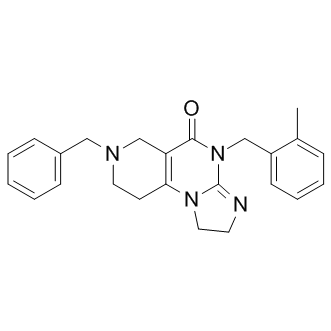All AbMole products are for research use only, cannot be used for human consumption.

TIC10 (ONC-201) is a potent, orally active, and stable small molecule that transcriptionally induces TRAIL in a p53-independent manner and crosses the blood-brain barrier. TIC10 inactivates Akt and ERK to induce TRAIL through Foxo3a, possesses superior compound properties: delivery across the blood-brain barrier, superior stability and improved pharmacokinetics.

Carcinogenesis. 2019 May 29.
Extracellular Vesicles-Derived OncomiRs Mediate Communication between Cancer Cells and Cancer-Associated Hepatic Stellate Cells in Hepatocellular Carcinoma Microenvironment.
TIC10 purchased from AbMole
| Cell Experiment | |
|---|---|
| Cell lines | HCT116 cells |
| Preparation method | Ability of TIC10 (5 μM) or TRAIL (25 ng/ml) to reduce cell viability in HCT116 cells after a 1-hour preincubation at the indicated temperatures (72 hours, n = 3). |
| Concentrations | 5 μM |
| Incubation time | - |
| Animal Experiment | |
|---|---|
| Animal models | Female athymic nu/nu mice |
| Formulation | DMSO |
| Dosages | 25, 50, 100 mg/kg |
| Administration | Intraperitoneal/oral |
| Molecular Weight | 386.49 |
| Formula | C24H26N4O |
| CAS Number | 1616632-77-9 |
| Solubility (25°C) | DMSO: ≥ 12 mg/mL (Need warming) |
| Storage |
Powder -20°C 3 years ; 4°C 2 years In solvent -80°C 6 months ; -20°C 1 month |
| Related Akt Products |
|---|
| ZINC00784494
ZINC00784494 is a specific Lipocalin-2 (LCN2) inhibitor. ZINC00784494 inhibits cell proliferation, cell viability and reduces AKT phosphorylation levels in SUM149 cells. |
| (E)-Akt inhibitor-IV
(E)-Akt inhibitor-IV is a PI3K-Akt inhibitor, with potent cytotoxic. |
| K-80003
K-80003 is a potent inhibitor of tRXRα-dependent Akt activation and cancer cell growth. |
| FPA-124
FPA-124, a cell-permeable copper complex, is a selective Akt inhibitor with an IC50 of 0.1 μM. |
| SPOP-IN-1
SPOP-IN-1 is a selective SPOP E3 ubiquitin ligase inhibitor. |
All AbMole products are for research use only, cannot be used for human consumption or veterinary use. We do not provide products or services to individuals. Please comply with the intended use and do not use AbMole products for any other purpose.


Products are for research use only. Not for human use. We do not sell to patients.
© Copyright 2010-2024 AbMole BioScience. All Rights Reserved.
